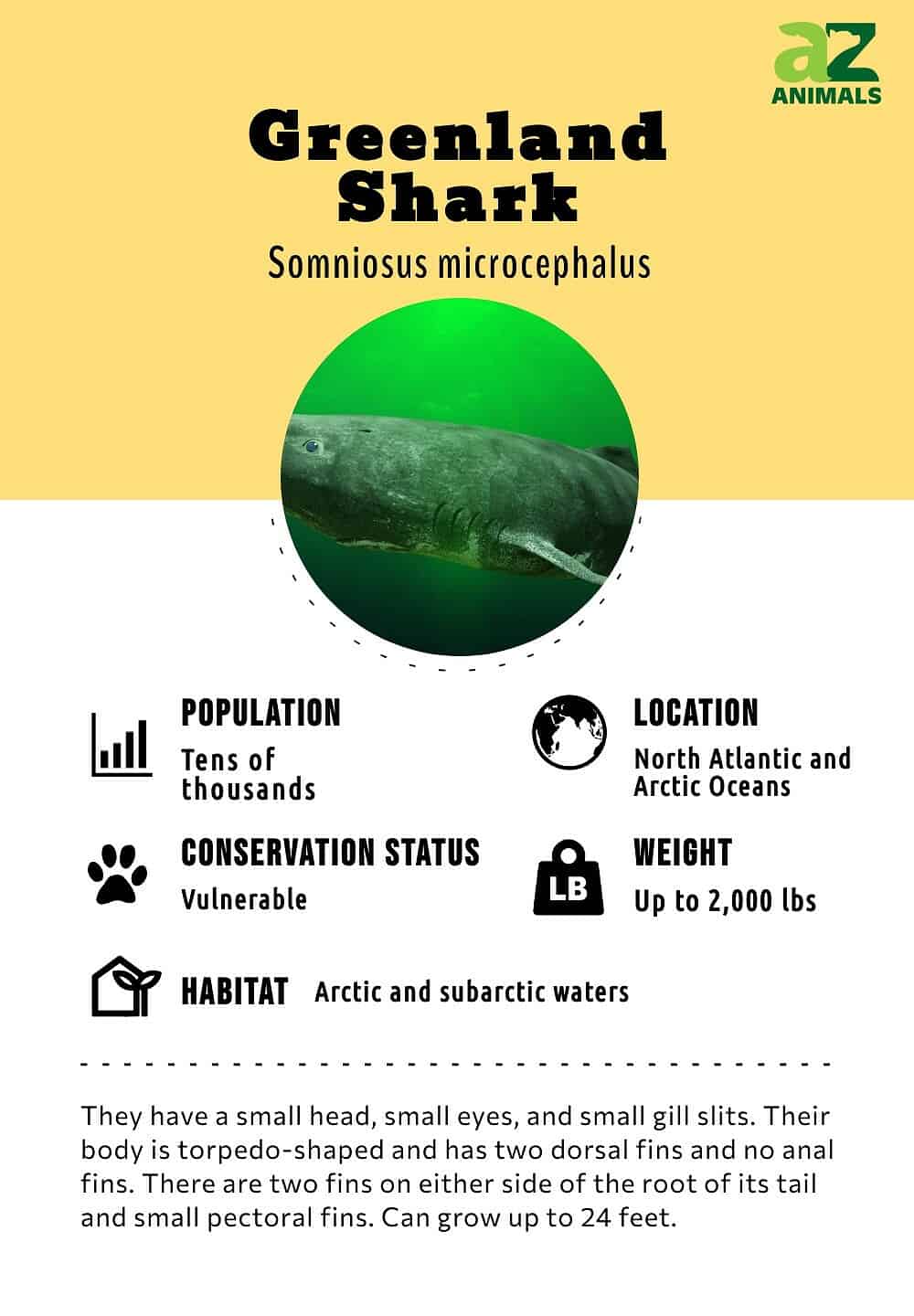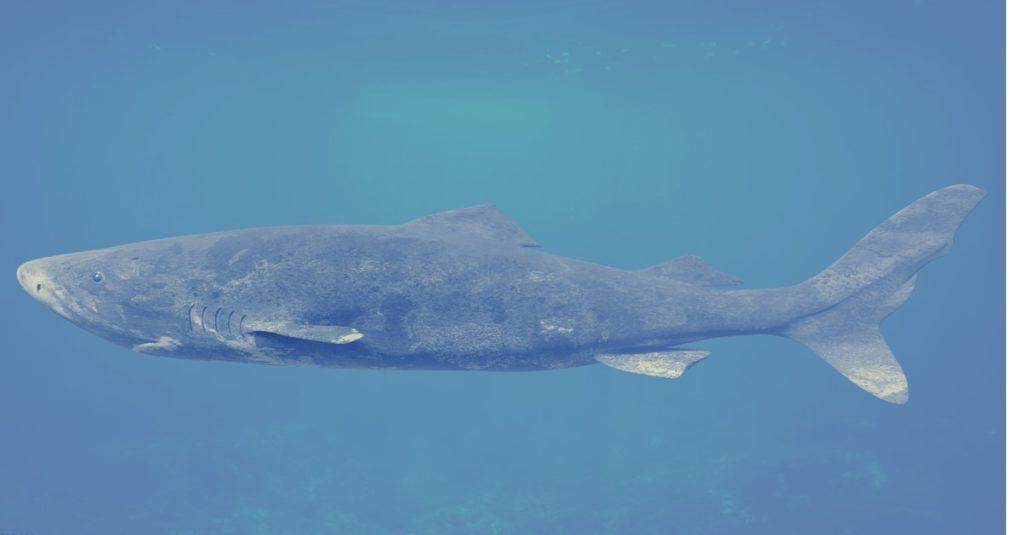Greenland Shark
Somniosus microcephalus
This shark has the longest lifespan of any vertebrate.
Advertisement
Greenland Shark Scientific Classification
- Kingdom
- Animalia
- Phylum
- Chordata
- Class
- Chondrichthyes
- Order
- Squaliformes
- Family
- Somniosidae
- Genus
- Somniosus
- Scientific Name
- Somniosus microcephalus
Read our Complete Guide to Classification of Animals.
Greenland Shark Conservation Status
Greenland Shark Facts
- Prey
- Smaller sharks and small whales, herring, cod and other fish, seals and squid.
- Name Of Young
- Pup
- Group Behavior
- Largely solitary
- Fun Fact
- This shark has the longest lifespan of any vertebrate.
- Estimated Population Size
- Several thousand
- Biggest Threat
- Climate change, overfishing
- Most Distinctive Feature
- Their great age.
- Other Name(s)
- Gurry, eqalussuaq, grey shark, sleeper shark
- Gestation Period
- Eight to 18 years
- Litter Size
- 10
- Habitat
- Deep, cold, waters of the North Atlantic and the Arctic Oceans.
- Predators
- Humans
- Diet
- Carnivore
- Favorite Food
- Greenland shark food includes fish, marine mammals and carrion.
- Type
- Fish
- Common Name
- Greenland Shark
- Number Of Species
- 1
- Location
- Canada, Greenland, Iceland
- Group
- School or shiver
View all of the Greenland Shark images!
“The Greenland shark is considered the Methuselah of Sharks.”
The Greenland shark, called eqalussuaq by the Inuit people is famous for living to a great age. Biologists believe that this large, slow fish can live to be half a millennia old. Its longevity probably has something to do with the fact that it does everything slowly. It swims slowly. It reproduces slowly. It catches prey by sneaking up on them when they’re asleep and then attacking.
The oldest of these animals has been around since Shakespeare, the signing of the Declaration of Independence and the French Revolution and two World Wars, and all manner of human upheaval and doesn’t care. It was a female, who according to an estimation, was between 272 and 512 years old. “Slow and steady wins the race,” must be the philosophy of eqalussuaq!
4 Incredible Greenland Shark Facts!
- It is often parasitized by a copepod that has an affinity for its eyes. The copepod often blinds the shark but doesn’t affect either its overall health or ability to hunt.
- The Greenland shark isn’t ready to breed until it’s about 150 years old.
- The shark cuts chunks out of large carcasses by biting into it and rolling its jaw around.
- The female gurry shark is gravid for between 8 and 18 years before she gives birth.
You can check out more incredible facts about Greenland sharks.
Evolution And History
The earliest known presence of a Greenland shark, based on fossil records, was around 100 million years ago, during the Miocene era. It is believed they evolved from an ancestral sleeper shark found in the Arctic-Subartic region of Canada. All sharks evolved from the same species, which was a small, leaf-shaped fish that did not have any fins, bones, or eyes. It was from this ancient ancestor that we have the two main groups of fish found today. The oldest shark, considered the first true shark, was Cladoselache, which lived 380 million years ago.

Scientific Name
The Greenland shark’s scientific name is Somniosus microcephalus. Somniosus is from the Latin “somnus,” which means sleep, and microcephalus is New Latin for “tiny head.” While there is only one species of Greenland shark, they do belong to the family of sleeper sharks that includes 20 different species.
Types Of
While the Greenland shark is the only one of its kind, it does belong to a larger genus of sleeper sharks that has 20 different varieties. Some of these are:
- Pacific sleeper shark (Somniosus pacificus)
- Southern sleeper shark (Somniosus antarcticus)
- Little sleeper shark (Somniosus rostratus)
- Plunket’s shark (Scymnodon plunketi)
- Portuguese shark, or Portuguese dogfish (Centroscymnus coelolepis)
Appearance

Greenland sharks move very slowly and can grow as long as 24 feet.
©Dotted Yeti/Shutterstock.com
The Greenland shark can grow as long as 24 feet, which rivals the length of the Great White shark. Females are bigger than males.
The shark moves very slowly and even its rare bursts of speed only achieve about 1.6 miles per hour. It has the usual rough shark tegument that’s basically made out of teeth. Its skin ranges in color from light grey to blackish brown and sometimes shows spots or bands. The shark has a small head, small eyes, and small gill slits. The body is torpedo-shaped and has two dorsal fins and no anal fins. There are two fins on either side of the root of its tail and small pectoral fins. The shark has about 100 teeth, with 48 to 52 in its upper jaw and 18 to 52 in its lower jaw.
Behavior
Greenland sharks are solitary save the breeding season. Sometimes a group of sharks, called a shiver or a school will gather at a whale fall or the carcass of some other large animal. If a prey animal is small enough for the shark to eat it whole, it will come upon it, open its mouth, and simply suck it in. The gurry shark is often blinded by parasites but does not need its vision to help it find food. It can do this by smelling food, including rotting carcasses, in the water.
Habitat

Greenland sharks are native to the North Atlantic waters around Greenland, Canada, and Iceland. They are the only true sub-Arctic shark and the only shark that can tolerate Arctic temperatures year-round.
©Dotted Yeti/Shutterstock.com
The shark is found in the North Atlantic and Arctic Oceans though it’s been seen as far south as France and the coast of the southeastern United States. It can be found near the surface of the water and at depths of over 7000 feet.
Diet
The shark is an opportunistic carnivore and will eat just about anything it can digest. One of the more interesting facts about the gurry shark’s diet is that it’s not above scavenging for a meal. Its stomach contents have included parts of large animals such as moose and polar bears. At least one shark had managed to down a whole reindeer.
Predators And Threats
The Greenland shark is a huge animal, and though it doesn’t move fast, it is an apex predator and simply too big for other predators to handle. The exception to this, of course, is humans. Because it is overfished in places, its conservation status is vulnerable. Climate change also warms the cold waters it prefers.
What Eats The Greenland Shark?
Humans eat the Greenland shark, even though its flesh is toxic. It can be prepared in a way that makes it safe to eat.
What Does The Greenland Shark Eat?

The Greenland shark eats fish, squid, marine mammals such as seals and small whales, and carrion.
Reproduction And Life Cycle

Greenland sharks have never been seen mating. Pups are born live after a long gestation period.
©Dotted Yeti/Shutterstock.com
No one has ever seen Greenland sharks mating, but females have been seen with scars from bite marks. This suggests that these sharks mate like other sharks, with the male grabbing the female with his teeth to hold her still as he fertilizes her eggs internally.
After the eggs are fertilized, they remain within the mother until they hatch. Then, the pups are born live after a gestation that can take as long as 18 years. It is believed that a female shark gives birth to 10 pups at a time, and they will not be able to reproduce themselves until they are at least a century old.
Once the young are born, they are independent. Given her extremely long lifespan, a female Greenland shark can have hundreds of babies.
In Fishing And Cooking
Though its conservation status is vulnerable, about 1000 of these sharks are still deliberately caught every year, and three and a half times that many are the victims of by-catch. Humans hunt the shark for its hide and its flesh and until recently, the rich oil in its liver. Though its flesh is toxic to humans, it can be treated in a way that leaches the toxins out of it. The dish made from this treated meat is called Hákarl.
Greenland Shark Population
As of 2021, there are probably tens of thousands of these sharks in the wild.
View all 171 animals that start with GGreenland Shark FAQs (Frequently Asked Questions)
What is a Greenland shark?
The Greenland shark is a large, very long-lived cartilaginous fish that lives in the cold, deep water of the North Atlantic and Arctic Oceans.
Where does the Greenland shark live?
The Greenland shark lives in the waters around Greenland, Iceland, and Canada but has also been found swimming in France’s Seine River and off the coast of Georgia in the United States.
How old is the Greenland shark?
Though a Greenland shark can be the oldest being in any ocean, it belongs to the order Squaliformes, which is an old but not the oldest order of sharks. Squaliformes sharks evolved in the late Jurassic period, 163.5 to 145.5 million years ago.
Why does Greenland shark live so long?
Scientists aren’t really sure, but they believe the shark’s extreme longevity is because it has a very low metabolism. This helps them live in cold water. They grow only a centimeter a year and can grow to 24 feet long.
Why is Greenland shark so toxic?
The gurry shark is toxic because its tissues contain a chemical called trimethylamine N-oxide. This is a type of natural antifreeze that helps the shark survive in the cold water of its habitat.
Are Greenland sharks dangerous?
Greenland sharks don’t appear to be dangerous to human beings, despite their great size. There may have been a report of an attack many years ago, but recently there have been no reports of Greenland sharks attacking people.
Where do Greenland sharks live?
Usually, Greenland sharks live off the coasts of Greenland, Canada and Iceland.
Thank you for reading! Have some feedback for us? Contact the AZ Animals editorial team.
Sources
- National library of Medicine / Accessed July 2, 2021
- National Ocean Service / Accessed July 2, 2021
- Wired / Accessed July 2, 2021
- Wikipedia / Accessed July 2, 2021
- Animal Diversity Web / Accessed July 2, 2021















